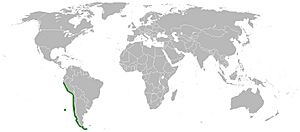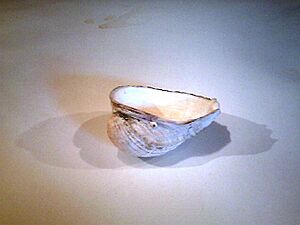Chilean abalone facts for kids
Quick facts for kids Chilean abalone |
|
|---|---|
 |
|
| Two live individuals of Concholepas concholepas; the one on the left has been turned over to show the underside of the large muscular foot | |
| Scientific classification | |
| Genus: |
Concholepas
|
| Species: |
concholepas
|
| Subspecies | |
|
|
 |
|
| Range of C. concholepas | |
| Synonyms | |
|
|
Concholepas concholepas, often called the Chilean abalone or Peruvian tolina, is a large, edible sea snail. It is a type of mollusk that lives in the ocean. Even though it looks a bit like a true abalone, it's actually part of a different family called Muricidae. These are also known as murex snails or rock snails.
This sea snail is found along the coasts of Chile and Peru. In Chile, people call it loco, which comes from a word in the Mapudungun language. In Peru, it's known as tolina or chanque.
Because too many of these snails were being caught, the Chilean government made laws in 1989 to limit how many could be harvested.
Contents
Shell Features of the Chilean Abalone
The Concholepas concholepas has a thick, slightly oval shell. Its color can range from white-brown to purple-grey. The shell has very few whorls, which are the turns or coils of a snail shell. This makes it look a bit like a Phrygian cap, a soft cone-shaped hat.
The outside of the shell has strong, wavy ridges that go in circles and also spread out from the center. The shell's opening, called the aperture, is very large. This is different from most other murex snails.
A loco cannot completely pull itself inside its shell if it's turned upside down. Because of this, it doesn't need a special lid, called an operculum, to close its shell. Instead, it uses its strong foot to hold onto rocks. The shell is made of calcite with a smooth inner layer of aragonite.
Where and How the Chilean Abalone Lives
Habitat and Diet of Concholepas concholepas
The Concholepas concholepas is a benthic predator. This means it lives on the bottom of the ocean, usually on rocks, and hunts other animals for food. It prefers cool waters, living from the sea surface down to about 40 meters deep.
Its diet mainly includes mussels, like Semimytilus algosus and Perumytilus purpuratus. It also eats barnacles, such as Chthamalus scabrosus.
Geographic Range of the Loco
You can find this sea snail from Lobos de Afuera in Peru all the way down to Cape Horn in Chile. This area also includes the Juan Fernández Islands.
Life Cycle of the Chilean Abalone
Concholepas concholepas are dioecious, meaning there are separate male and female snails. However, you can't tell them apart just by looking at them. Fertilization happens inside the female snail.
In central Chile, females lay their egg capsules on rocky surfaces in shallow waters during the autumn months. After about a month, tiny larvae are released from these capsules. These larvae, called veliger larvae, float in the water for about three months. Once they are ready, they settle down on rocks in shallow areas, up to 30 meters deep.
The snails usually reach sexual maturity when they are between 5.4 and 6.7 centimeters long. It takes them about four years to grow to this size.
How People Use Concholepas concholepas
Chilean Abalone in Cuisine
The Concholepas concholepas is a popular food in Chilean cuisine. It is sold around the world as a special food, often called "Chilean abalone" by mistake. Remember, true abalones eat plants, but the loco is a carnivore (meat-eater).
Because it is so valuable and important to the ocean's ecosystem as a top predator, it is one of the most studied marine animals in Chile.
Commercial Fishing for Loco
Along the Chilean coast, C. concholepas is a very important seafood. It is also a major product for the aquaculture industry, which is like farming in the water.
In 1975, about 5,000 tons of these snails were caught each year. By 1980, the catch reached its highest point at 25,000 tons. However, since 1989, catching them has been mostly illegal in Chile due to overfishing.
Since 1992, some special rules have allowed certain divers to catch them. The snails must be at least 10 centimeters long to be caught legally. Today, the only legal way for local fishermen to catch locos is if they have a special permit for a Marine Area of Benthonic Resources Extraction. Even in these areas, there are times of the year when catching them is not allowed.
Studies show that too much fishing has made the snail populations smaller. It has also led to a kind of artificial selection, where faster-growing snails are removed from the population. Scientists have been looking into farming these snails since 1986 to help with this problem.
Cooking with Loco
In Chilean cooking, the meat from the snail's foot is often cooked. It can be served with mayonnaise or made into a soup called chupe de locos. This soup is usually served in an earthenware bowl. A typical chupe de locos might include about six snail feet, some fatty cheese, two eggs, grated bread, salt, and paprika.
Possible Medical Uses
Scientists have found that a substance called hemocyanin in the blood of C. concholepas might help fight bladder cancer and prostate cancer. In a 2006 study, mice treated with this substance showed a good effect against bladder tumors. They lived longer, their tumors grew less, and there were no harmful side effects.
Other Scientific Uses
The shells of Concholepas concholepas can also help scientists study climate change. Many fossil shells are found in old coastal areas. These shells can provide clues about past ocean temperatures, especially in cold seas. This information can help us understand how the El Niño Southern Oscillation (ENSO) has changed over time.
See also
 In Spanish: Concholepas concholepas para niños
In Spanish: Concholepas concholepas para niños


